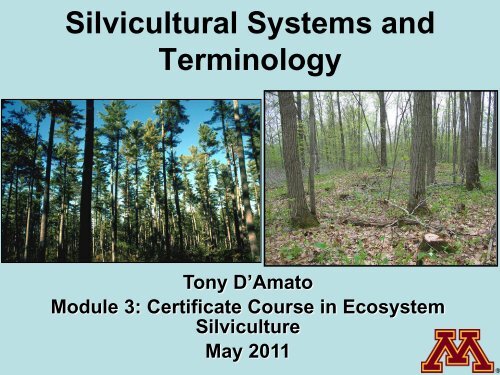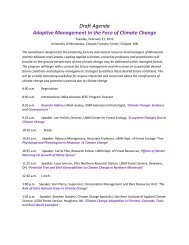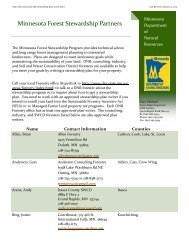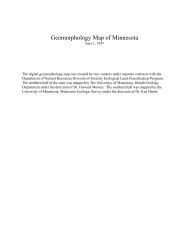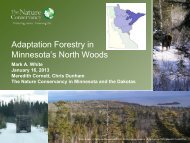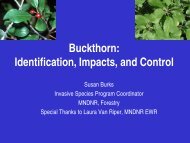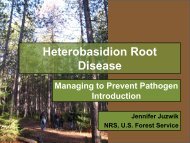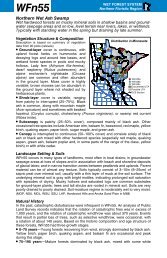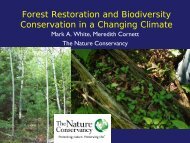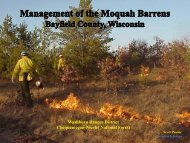Silvicultural Systems
Silvicultural Systems
Silvicultural Systems
You also want an ePaper? Increase the reach of your titles
YUMPU automatically turns print PDFs into web optimized ePapers that Google loves.
<strong>Silvicultural</strong> <strong>Systems</strong> and<br />
Terminology<br />
Tony D’Amato<br />
Module 3: Certificate Course in Ecosystem<br />
Silviculture<br />
May 2011
<strong>Silvicultural</strong> <strong>Systems</strong><br />
– Planned program of treatments over the<br />
entire life of the stand<br />
– Includes regeneration treatments, tending<br />
operations, intermediate treatments, and<br />
protection measures
<strong>Silvicultural</strong> <strong>Systems</strong><br />
• Regeneration method<br />
– Procedure by which the stand is established and<br />
renewed<br />
– <strong>Silvicultural</strong> systems are named after the<br />
regeneration method (e.g., shelterwood system)<br />
Shelterwood method<br />
Seed tree method
Stand initiation stage<br />
Stem exclusion stage<br />
Understory reinitiation stage<br />
From Nyland (1996)
Young Growth-stage 0-35 years<br />
M<br />
R<br />
R<br />
Extended Transition-stage 35-115 years<br />
Old-Growth-stage >115 years<br />
T<br />
T<br />
• Determine<br />
outcomes of<br />
treatments for<br />
maintaining species<br />
and structures<br />
M<br />
M=maintenance harvest<br />
T=transition harvest<br />
R=regeneration harvest
Regeneration Methods
Classification of Regeneration Methods<br />
• Based on two factors:<br />
1. Distinction between sprouts (i.e., suckers,<br />
stump sprouts) and seedlings (from seed) as<br />
sources of regeneration (Low- vs. Highforest<br />
methods)
Classification of Regeneration Methods<br />
• Based on two factors (cont.):<br />
2. The arrangement of cuttings in time (Evenvs.<br />
Uneven-Aged Methods)
Low-Forest Methods<br />
• Rely largely on vegetative regeneration from<br />
stump sprouts, root suckers, or layered<br />
branches<br />
– Coppice method – any type of cutting in which<br />
dependence is placed mainly on vegetative<br />
reproduction
High-Forest Methods<br />
• Regeneration of stands based on sexual<br />
reproduction (germinated seed)<br />
– Even-aged methods - entire community of mature<br />
trees is removed in one or more cuttings over a<br />
short interval of time to allocate growing space to a<br />
new, even-aged cohort
Even-Aged, High-Forest Methods<br />
• Clearcutting Method<br />
– Removal of the entire stand in one cutting<br />
– Regeneration occurs following harvest, either<br />
through artificial means (seeding, planting) or seeds<br />
germinating after harvest
Even-Aged, High-Forest Methods<br />
• Seed-Tree Method<br />
– Removal of the old stand in one cutting, except for a<br />
small number of seed trees left singly or in small<br />
groups<br />
– Seed trees provide for establishment of advance<br />
regeneration
Even-Aged, High-Forest Methods<br />
• Shelterwood Method<br />
– Removal of old stand in a series of cuttings<br />
extending over a relatively short portion of the<br />
rotation<br />
– Encourages the establishment of one cohort of<br />
advance regeneration under the partial shelter of<br />
seed trees
Two-Aged, High Forest Methods<br />
• Most of the mature forest is removed, but<br />
widely spaced vigorous trees are left to<br />
grow above the new cohort<br />
Shelterwood with Reserves<br />
Clearcut with Reserves
Irregular shelterwood methods<br />
• “Irregular” refers to stands in which distribution of<br />
age classes is unbalanced<br />
‣ Irregular heights and spatial arrangement of trees
Group shelterwood<br />
components (small gaps)<br />
Baden Femelschlag
Matrix surrounding gaps<br />
(uniform shelter)<br />
Baden Femelschlag
Uneven-Aged, High Forest Methods<br />
• Uneven-Aged Methods – only some trees in a<br />
community have reached maturity and are<br />
removed over an extended time period to<br />
allocate space to a new age class
Uneven-Aged, High Forest Methods<br />
• Selection methods – occasional<br />
replacement of single trees or small groups<br />
of trees with regeneration from any source<br />
Single-tree selection<br />
Group selection
SHADES OF GRAY<br />
• Depending on objectives and stand conditions,<br />
hybrid approaches can be applied that combine<br />
multiple regeneration methods in same stand or<br />
harvest unit
Intermediate Treatments
Intermediate Treatments<br />
• Treatments applied to improve the existing<br />
stand, regulate its growth, and provide for early<br />
financial returns, without any effort directed<br />
at regeneration.
Release Treatments<br />
• Weeding: treatment applied during the<br />
seedling stage to eliminate or suppress mainly<br />
herbaceous plants or shrubs before they<br />
overtop or interfere with desired trees
Release Treatments<br />
• Cleaning: treatment applied during the sapling<br />
stage to free selected trees of better species<br />
and quality from overtopping trees of<br />
comparable age
Release Treatments<br />
• Liberation cutting: freeing young trees not<br />
past the sapling stage from competition from<br />
older overtopping trees<br />
– Often corrects problem not addressed by earlier site<br />
preparation (poor quality, undesirable trees left<br />
during past logging)
Thinning Treatments<br />
• Thinning: the removal of live trees from a<br />
stand with the intention of improving growing<br />
conditions on the site for the uncut or leave<br />
trees
Thinning Treatments<br />
• Pre-commercial thinning (PCT): thinning<br />
before the cut trees have sufficient<br />
merchantable volume to yield adequate volume<br />
for commercial harvesting<br />
– Early investment to increase the net return from<br />
the whole crop
Commercial Thinning Methods
Thinning Methods<br />
• Based on how individual trees are chosen for<br />
removal<br />
– Crown position in canopy (crown classes – Kraft<br />
classification)<br />
• Low, crown, and selection thinning<br />
– Predetermined spacing or pattern of removal w/o<br />
regard for crown position or quality<br />
• Geometric (mechanical) thinning
Thinning Methods<br />
• Low Thinning (thinning from below)<br />
– Favors development of dominants and codominants<br />
through the removal of lower crown classes<br />
– Leave more valuable trees<br />
– Emulates natural development processes
Thinning Methods<br />
• Crown thinning (thinning from above)<br />
– Favor dominants and codominants by removing<br />
other dominants and codominants<br />
• Favoring best quality crop trees in stand<br />
– Intentionally make holes in canopy around crop<br />
trees
Thinning Methods<br />
• Selection thinning (dominant thinning)<br />
– Removal of trees in dominant crown classes in<br />
order to favor lower crown classes<br />
– Relies on smaller trees to respond to open growing<br />
conditions (risk of windthrow, thinning shock)<br />
– Can become high-grading
Thinning Methods<br />
• Geometric Thinning (mechanical thinning)<br />
– Trees are removed in proportion to their occurrence<br />
(no crown class considerations)<br />
– Removals are made to maintain a predetermined<br />
spacing among trees<br />
– Operationally efficient (thin in rows, every other<br />
tree)
Thinning Methods<br />
• Free thinning<br />
– When faced with stand with irregular structure, it<br />
may not make sense to do any of the above<br />
thinnings<br />
– Apply all other elements of thinning at once<br />
– Thin to approve stand structure
Variable Density Thinning<br />
– Thinning regime in which thinning intensity and tree<br />
marking rules are varied within stand of interest<br />
• Increases heterogeneity in stand density and cover<br />
– Emulates natural variation in stand structure<br />
resulting from competitive mortality and small-scale<br />
canopy disturbance
Variable Density Thinning<br />
– Often called “skips-and-gaps” approach<br />
• Portions of stand are left lightly or completely unthinned<br />
(“skips”)<br />
– High stem density, heavy shade<br />
• Other portions are heavily harvested (“gaps”), including<br />
removal of dominant trees<br />
– Increases understory development (REGENERATION)<br />
• Remaining matrix is often thinned to intermediate levels<br />
(e.g., 70% of initial basal area)
skip<br />
thinned<br />
matrix<br />
gap
Final Point<br />
• <strong>Silvicultural</strong> systems are an expression of<br />
your collective creativity in meeting a desired<br />
future condition<br />
– Well-defined approaches exist; however, these<br />
methods should be applied with flexibility and<br />
creativity to meet ever-evolving objectives


